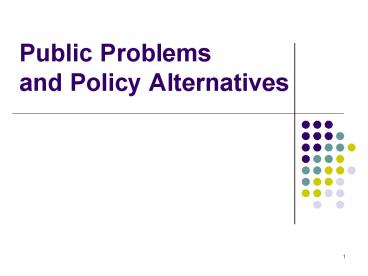Public Problems and Policy Alternatives PowerPoint PPT Presentation
1 / 14
Title: Public Problems and Policy Alternatives
1
Public Problems and Policy Alternatives
2
Analyzing Problems
- Describe the problem
- Find causes
- Identify other aspects of the problem
3
Describing The Problem
- Definitions
- Sometimes are obvious, sometimes not
- Are important for clarification (e.g., how many
people are living in poverty) - Allow people to communicate with one another
effectively - Measurements
- There are different ways to measure problems
- Quantitative
- Qualitative
- Spatial
- Other
4
Describing The Problem, cont.
- Comparisons
- Absolute
- Relative
- Historical
5
Finding Causes
- Involves determining the contributing factors
- Answers to these questions may help to determine
how to solve the problem, but - They may also lead to conflict
- Where there are multiple causes
- Disagreement over which one to address
6
Identifying Other Aspects
- Political considerations
- How a problem is defined can shape the
development of potential solutions - Future considerations
- How will the problem change and develop
- Involves forecasts and extrapolations
7
Finding Information
- Internet
- Government publications
- Major newspapers and magazines
- Non-profit organizations
- Think tanks
- Journals (scholarly)
- Books
8
Constructing Alternatives (i. e. courses of
action)
- What government can do
- Regulate
- Prohibit, require, license, inspect, ration,
enforce standards - Use fiscal tools
- Loans, subsidies, price supports, taxes, fees,
incentives - Educate
- Inform public
- Conduct research
- Manage
- Provide a service
- Contract for a service
- Privatize a service
- Establish a public trust
9
Policy Design Questions
- Who are the relevant government agents
- Who is the target population
- How to get individuals to do something they would
not ordinarily do, or to modify their behavior
10
Means Of Changing Behavior
- Authority tools
- Invoke governments legitimacy
- People behave because an authority asks them to
- Inducements/sanctions
- Encourage behavior through incentives and/or
penalties - Capacity building tools
- Provide training or education to empower people
11
Means Of Changing Behavior, cont.
- Hortatory tools
- Invoke images and symbols to get people to behave
a certain way - Learning tools
- Provide opportunities to participate in
policymaking
12
Thinking Creatively and Generating Ideas
- No action analysis (the default option)
- Begin w/status quo as a baseline
- Keeping present policies may be viable option
- Quick surveys
- Talking w/people within policy network to see
what ideas they have - Literature review
- Examination of material to see what has been
proposed
13
Thinking Creatively and Generating Ideas (cont)
- Case studies
- Examine what has worked in similar situations
- State governments provide opportunities
- Parallel situations/analogies
- Look at other policy areas to see if ideas can be
adapted - Brainstorming
- Comparison to ideal
- Envisioning ideal to generate ideas
14
(No Transcript)

